Bracken fern (
Pteridium aquilinum) is a perennial fern that is distinguished by it's large, broadly triangular fronds that are divided into three main parts, with each part bipinnately subdivided. Bracken fern is usually found in open wounds on sandy and gravelly soil, dry pastures and meadows, and abandoned fields.
Toxic components
Bracken fern contains high amounts of the enzyme thiaminase, which is present in all parts of the plant.
Thiaminase inhibits absorption of the necessary vitamin thiamin (B1), pyrimidine, and thiazole. The amount of thiaminase present in the plant varies depending on the time of year and is at its maximum amount in the summer. Bracken fern remains toxic even when it's withered or dried, such as when it is accidentally baled into hay. In fact, if it is stored, the resulting toxic effects often increase. Bracken fern is palatable to some horses, who will seek it out even when other forages are available. Late summer is generally when most poisonings occur in horses, when other forage sources may be scarce or dried out from drought periods.
Clinical Signs
Horses poisoned by bracken fern may initially show signs of a "tucked up" appearance, unsteady gait, change in behavior (such as acting nervous or timid), and/or congested mucous membrances. As the condition progresses, horses may stand abnormally, with their legs spread apart, and if asked to walk, will do so with a staggering gait.
 Attention! This is a potentially life-threatening condition for your horse. Time is of the essence, contact your veterinarian immediately.Find a Vet
Attention! This is a potentially life-threatening condition for your horse. Time is of the essence, contact your veterinarian immediately.Find a Vet